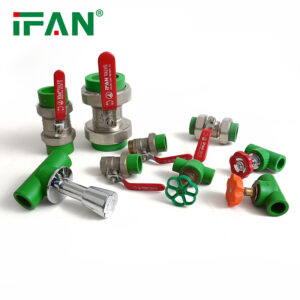Description
The Ultimate Guide to PPR Pipe Fittings: Everything You Need to Know
Introduction:
PPR pipe fittings have become a popular choice for plumbing needs in recent years. They are durable, easy to install, and provide excellent performance.
What are PPR Pipe Fittings?
PPR stands for polypropylene random copolymer, a thermoplastic material used to make pipe fittings. PPR pipe fittings are used for water supply systems and can withstand high temperatures and pressures.
Types of PPR Pipe Fittings:
There are several types of PPR pipe fittings, including couplings, elbows, tees, reducers, and end caps. These fittings are available in various sizes and can be used for different purposes.
Advantages of PPR Pipe Fittings:
• Durability: PPR pipe fittings are durable and can last for years without needing replacement.
• Easy to install: These fittings are easy to install, and you don’t need special tools or training.
• Corrosion-resistant: PPR pipe fittings are resistant to corrosion, rust, and chemical damage.
• High temperature and pressure resistance: These fittings can withstand high temperatures and pressures without any deformation or damage.
• Low thermal conductivity: PPR pipe fittings have low thermal conductivity, which means they can keep water temperature stable.
• Cost-effective: Overall, PPR pipe fittings are a cost-effective plumbing solution.
How to choose PPR Pipe Fittings?
When selecting PPR pipe fittings, there are a few things to consider:
• Size: Make sure you choose the right size fitting for your plumbing needs.
• Purpose: Determine what type of fitting you need based on your plumbing requirements.
• Quality: Look for high-quality PPR pipe fittings to ensure durability and performance.
• Compatibility: Check the fitting’s compatibility with other plumbing systems and components.
Installation of PPR Pipe Fittings:
PPR pipe fittings are easy to install, and you don’t need any special tools or training. Follow these steps for successful installation:
1. Cut the pipes to the required length and clean the edges.
2. Mark the insertion depth of the fitting on the pipe.
3. Heat the fitting and pipe separately with a heating tool. Make sure the fitting is evenly heated.
4. Insert the pipe into the fitting and fit it all the way to the mark.
5. Hold the joint for a few seconds until it cools down and solidifies.
Maintenance of PPR Pipe Fittings:
PPR pipe fittings require little maintenance, but it’s essential to pay attention to a few things:
• Inspect the joints regularly to ensure there are no leaks and damage.
• Avoid using harsh chemicals that can damage the fittings.
• Clean the fittings periodically to prevent the build-up of debris and dirt.
Conclusion:
PPR pipe fittings are an excellent plumbing solution that provides durability, performance, and affordability. They offer many benefits and are easy to install and maintain. Choose high-quality PPR pipe fittings for a reliable and long-lasting plumbing system.
Meta Description:
Discover everything you need to know about PPR pipe fittings, their benefits, installation, maintenance, and how to choose the right fitting for your plumbing needs.
Related products
-
PPR Fittings
Easy to Install Brass Fittings for DIY Projects
-
PPR Fittings
Versatile Brass Fittings for All Your Plumbing Needs
-
PPR Fittings
PPR Material Pipe Fittings











